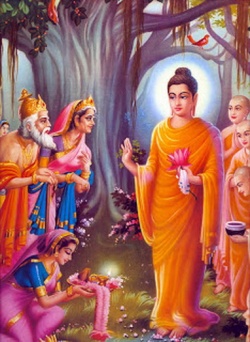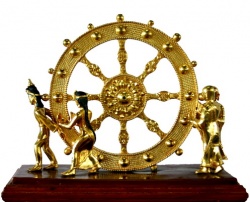Aśokāvadāna
The Ashokavadana (Sanskrit: अशॊकवदन, "Narrative of Ashoka") is a 2nd-century CE text that describes the birth and reign of the Maurya Emperor Ashoka the Great. It contains legends as well as historical narratives, and glorifies Ashoka as a Buddhist emperor whose only ambition was to spread Buddhism far and wide.
Ashokavadana is one of the avadana texts contained in the Divyavadana ("Divine Narrative"), an anthology of several Buddhist legends and narratives. According to Jean Przyluski, the text was composed by the Buddhist monks of the Mathura region, as it highly praises the city of Mathura, its monasteries and its monks. Also known as Ashokarajavadana, it was translated into Chinese by Fa Hien in 300 CE as A-yu wang chuan, and later as A-yu wang ching(zh:阿育王经) in 500 CE.:16 It was translated into French by Jean Przyluski in 1923, and in English by John S. Strong in 1983.
Life of Upagupta
The text begins with the stories about the Buddhist monk Upagupta, described as the spiritual teacher of Ashoka. It first describes his past lives, his birth and his youth in Mathura. It then goes on to given an account of his encounters with a courtesan named Vasavadatta and his ordination as a monk. Ashokavadana further tells of his conversion of Mara.:16
Early life of Ashoka
One of the legends in the text describes an incident the previous birth of Ashoka, when he was named Jaya. It states that Jaya met Gautama Buddha as a young boy, and gifted him a bowl of dirt, dreaming that the dirt is food. The Buddha then predicted that several years after his parinirvana, the boy would be born as a chakravarti king ruling from Pataliputra.
The Ashokavadana states that Ashoka's father Bindusara did not like him, because he was ugly. Ashoka killed his step-brother and the legitimate heir by tricking him into entering a pit with live coals, and became the king. He became notorious for his bad temper, and had 500 of his ministers killed because he believed that they were not loyal enough. He also had the women in his harem burnt to death when some of them insulted him. He built an elaborate torture chamber, termed as the "hell on earth" or Ashoka's Hell. Once he encountered a Buddhist monk, who was not troubled by any of the sufferings. Impressed by the monk, Ashoka converted to Buddhism, became a pious man and built 84,000 stupas.:17 Like other Buddhist legends, the text intends to dramatize the change resulting from the Ashoka's conversion, and therefore, exaggerates Ashoka's past wickedness and his piousness after the conversion.
Ashoka's Buddhist kingship
The text describes in detail the efforts of Ashoka towards the expansion of Buddhism. According to Ashokavadana, Ashoka first converted his brother Vitasoka to Buddhism. Next, he taught his minister Yashas to honor the Buddhist monks.Then, accompanied by Upagupta, he went on a pilgrimage to the holy places associated with the Buddha's life. He held a grand pancavarsika (quinquennial) festival for the Buddhist monks, during which he encountered Pindola Bharadvaja.:17
The text also tells of Ashoka's son Kunala, who became a blind beggar due to a plot hatched by Ashoka's young queen Tisyaraksita. Kunala achieved enlightenment and was later united with his father.:18 It makes no mention of Mahinda, the son of Ashoka who introduced Buddhism to Sri Lanka according to Mahavamsa and Dipavamsa.
Ashokavadana mentions two incidents of Ashoka turning away from non-violence after adopting Buddhism. In one instance, a non-Buddhist in Pundravardhana drew a picture showing the Buddha bowing at the feet of Nirgrantha Jnatiputra (identified with Mahavira, the founder of Jainism). On complaint from a Buddhist devotee, Asoka issued an order to arrest him, and subsequently, another order to kill all the Ajivikas in Pundravardhana. Around 18,000 followers of the Ajivika sect were executed as a result of this order.:232 Sometime later, another Nirgrantha follower in Pataliputra drew a similar picture. Asoka burnt him and his entire family alive in their house. He also announced an award of one dinara (silver coin) to anyone who brought him the head of a Nirgrantha heretic. According to Ashokavadana, as a result of this order, his own brother was mistaken for a heretic and killed by a cowherd. According to K.T.S. Sarao, stories of persecutions of rival sects by Ashoka appear to be a clear fabrication arising out of sectarian propaganda.
According to the text, Ashoka started gifting away his empire's resources to the sangha during his last days. His ministers denied him the access to the state treasury amidst fears that he would empty it. Ashoka then gifted away all of his personal possessions and died in peace.
Description of the Sunga rule
The Ashokavadana ends with the story of the Sunga king Pusyamitra (185–151 BCE), whose rule succeeded the Mauryan empire. It has often been quoted for its disparaging description of Pusyamitra as an enemy of the Buddhist faith, which before him had been officially supported by the Mauryan empire::293
“ ... Pusyamitra equipped a fourfold army, and intending to destroy the Buddhist religion, he went to the Kukkutarama. ... Pusyamitra therefore destroyed the sangharama, killed the monks there, and departed. ... After some time, he arrived in Sakala, and proclaimed that he would give a ... reward to whoever brought him the head of a Buddhist monk ”
Like other portions of the text, these accounts are regarded by many historians as being exaggerated.


